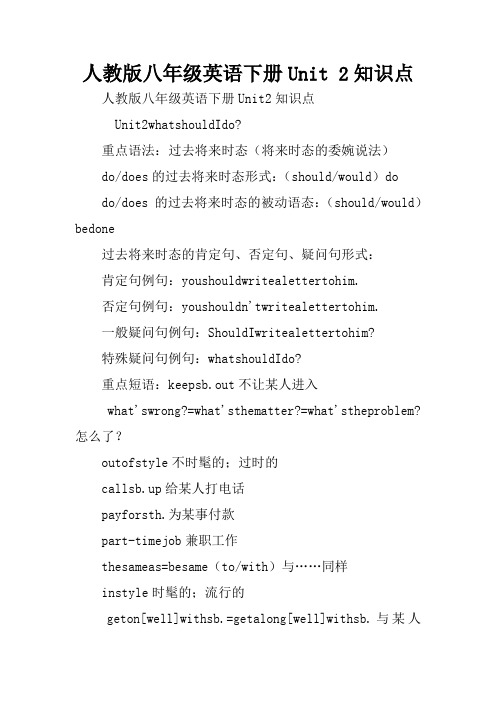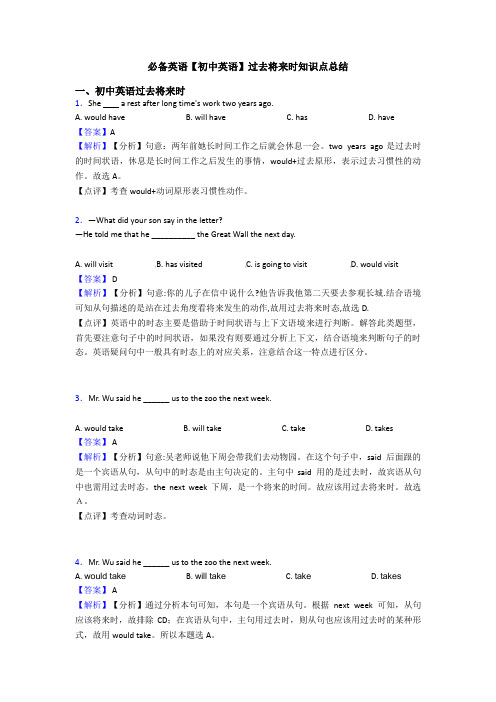八下第二单元初中英语过去将来时讲解
- 格式:docx
- 大小:17.41 KB
- 文档页数:2

人教版八年级英语下册Unit 2知识点人教版八年级英语下册Unit2知识点Unit2whatshouldIdo?重点语法:过去将来时态(将来时态的委婉说法)do/does的过去将来时态形式:(should/would)dodo/does的过去将来时态的被动语态:(should/would)bedone过去将来时态的肯定句、否定句、疑问句形式:肯定句例句:youshouldwritealettertohim.否定句例句:youshouldn'twritealettertohim.一般疑问句例句:ShouldIwritealettertohim?特殊疑问句例句:whatshouldIdo?重点短语:keepsb.out不让某人进入what'swrong?=what'sthematter?=what'stheproblem?怎么了?outofstyle不时髦的;过时的callsb.up给某人打电话payforsth.为某事付款part-timejob兼职工作thesameas=besame(to/with)与……同样instyle时髦的;流行的geton[well]withsb.=getalong[well]withsb.与某人相处(好)didn't=didnotcouldn't=couldnotas…aspossible尽可能……(eg/assoonaspossible尽快)allkindsof各种;许多ontheonehand一方面ontheotherhand另一方面asksb.forsth.=asksb.todosth.请求某人做某事asksb.nottodosth.请求某人不要做某事spend(money)onsth.=spend(money)[in]doingsth.花钱做某事sth.costsb.(money)某人花钱为了某事takesb.sometimetodosth.花某人时间做某事findout查明findsb.doingsth.发现某人做某事beangrywithsb.生某人的气beangryatsth.生某事的气thesameageas=asoldas与某人年龄一样havefightwithsb.与某人打架learntodosth.学会做某事not…until…直到……才……comparesth.(A)withsth.(B)把某事(A)与某事(B)作比较it'stimeforsth.=it'stimetodosth.到该做某事的时间了maybeadv.或许maybe(情态动词+动词原形)可能是shall→should情态动词shall的原形和过去式pay→paid→paid动词pay的原形、过去式和过去分词ReadingStrategy(阅读方法)youwilllearntousenewwordsbetterifyouusealearner'sdi ctionary.(时刻学着应用新单词来学习比时刻使用字典这种途径方法更好。

过去将来时1过去将来时的定义主要表达在过去某仪点时间看将来可能会发生的事情.一般过去将来时的出发点是过去,即从过去某一时刻看以后要发生的动作或状态。
过去将来时的时间状语:1) at six the next morning, at two the next afternoon, at eight the nextnight, the next day,the next Friday, the next week, the next month, the next year2)the following day, the following week,the following month,the following year3)two days later, three weeks later, four years later4) after10 o'clock,after 10 o'clock in the morning, after 9 o'clock5)when,after引导的时间状语从句。
2过去将来时的构成及基本句型过去将来时构成:一般过去将来时是由"should / would +动词原形"构成的。
(一般过去将来时常用于间接引语中)过去将来时的基本句型,肯定句:be(was,were)going toShe said she was going to start off at once.她说她将立即出发。
否定句:be(was,were)not going to在be动词后直接加not,She said she was not going to start off at once.她说她不会立即出发。
疑问句:Be(Was,Were)+主语+going to+动词原形+其它把be动词提前到句首。
但在宾语从句中从句改为一般疑问句时多为多用if,whether作连接词。

八年级下册英语第二单元知识点笔记八年级下册英语第二单元知识点笔记一、动词形态1. 不规则动词过去式:例如,go是goes的过去式,goes是其他现在时的动词形式。
2. 动词的过去分词形式:例如,run的过去分词是ran。
3. 无动词的现在分词形式:例如,swimming是在swim的基础上加-ing 的结果。
二、时态和语态1. 现在时:表示现在正在发生的事情或习惯性的行为。
2. 过去时:表示过去发生的事情。
3. 将来时:表示将来要发生的事情。
4. 过去完成时:表示在过去某个时间点之前完成的动作。
5. 现在完成时:表示过去某个时间点之前开始的动作,直到现在还未完成。
6. 被动语态:表示动作的承受者,而不是执行者。
三、句型1. What 引导的问句:用于询问某人的职业、爱好等信息。
2. How 引导的问句:用于询问做某事的方式或程度。
3. 祈使句:用于命令、建议或请求。
4. 疑问代词引导的句子:包括who、whom、whose、which、what等,用于问句中的主谓宾语或定语。
四、介词和固定搭配1. in 搭配:在一些日期、季节和特定的时间段中使用。
2. on 搭配:在特定日期、时间和星期几中使用。
3. at 搭配:在具体时间和场所中使用。
4. get up 和 wake up 区别:get up 表示起床,wake up 表示从睡眠中醒来。
五、小词汇1. prefer:表示对两种或多种事情中更喜欢或更偏爱哪一种。
2. suggest:表示建议或提议某事。
3. might:用于表示可能性,也可以在请求、建议、邀请等语气中使用。
4. apologize:表示向另一个人道歉或表示内心的抱歉之情。
六、元音和辅音1. 元音:a、e、i、o、u.2. 辅音:b、c、d、f、g、h、j、k、l、m、n、p、q、r、s、t、v、w、x、y 和 z.以上是我对八年级下册英语第二单元的学习笔记总结。
这些知识点和语法结构对于英语学习过程中的掌握和理解非常重要。

初中语法时态学习之(七)过去完成时1.【概念】过去完成时表示在过去某一时间或动作之前已经发生或完成了的动作,即“过去的过去(past-in-the-past )”。
----|-------------------------- |-------------------------------|---------------------------->那时以前那时现在Eg:I had been at the bus stop for 20 minutes when a bus finally came.当车来的时候,我在车站已等了20分钟.(此句义表示在车来的那一刻,我在车站等待这个动作已经发生在车来之前,就表示发生在“过去的过去) 2.【结构】主语+had+V过去分词3.【时间状语】before,when,after,by+,until, once,had no sooner……than,yet,already+【过去的时间】等。
(注意:过去完成时和现在完成时在句中的使用区别关键看主从句的时态)【过去完成时-语法判定】1. 由时间状语来判定一般说来,各种时态都有特定的时间状语。
与过去完成时连用的时间状语有:( 1 )by + 过去的时间点。
Eg: I had finished reading the novel by nine o'clock last night.(在昨晚九点,我就看完小说了。
)( 2 )by the end of + 过去的时间点。
Eg: We had learned over two thousand English words by the end of last term.(在上学期末,我就已经学会了超过2万个英语单词.)( 3 )before + 过去的时间点。
Eg: They had planted six hundred trees before last Wednesday.(上周三,他们就已经种植了600棵树。

必备英语【初中英语】过去将来时知识点总结一、初中英语过去将来时1.She a rest after long time's work two years ago.A. would haveB. will haveC. hasD. have【答案】A【解析】【分析】句意:两年前她长时间工作之后就会休息一会。
two years ago是过去时的时间状语,休息是长时间工作之后发生的事情,would+过去原形,表示过去习惯性的动作。
故选A。
【点评】考查would+动词原形表习惯性动作。
2.—What did your son say in the letter?—He told me that he __________ the Great Wall the next day.A. will visitB. has visitedC. is going to visitD. would visit【答案】 D【解析】【分析】句意:你的儿子在信中说什么?他告诉我他第二天要去参观长城.结合语境可知从句描述的是站在过去角度看将来发生的动作,故用过去将来时态,故选D.【点评】英语中的时态主要是借助于时间状语与上下文语境来进行判断。
解答此类题型,首先要注意句子中的时间状语,如果没有则要通过分析上下文,结合语境来判断句子的时态。
英语疑问句中一般具有时态上的对应关系,注意结合这一特点进行区分。
3.Mr. Wu said he ______ us to the zoo the next week.A. would takeB. will takeC. takeD. takes【答案】 A【解析】【分析】句意:吴老师说他下周会带我们去动物园。
在这个句子中,said 后面跟的是一个宾语从句,从句中的时态是由主句决定的。
主句中said 用的是过去时,故宾语从句中也需用过去时态。
the next week 下周,是一个将来的时间。

初二下英语重点语法下面是小编收集整理的初二下重点语法,欢迎阅读。
一般将来时态的应用do/does 的一般将来时态形式:(shall/will) dodo/does 的一般将来时态的被动语态:(shall/will) be done一般将来时态的肯定句、否定句、疑问句形式:肯定句例句:People will have robots in a few years.否定句例句:People (will not/won't) have robots in a few years.一般疑问句例句:Will people have robots in a few years?特殊疑问句例句:What will people have in a few years?过去将来时一、过去将来时的结构should/would+动词原形do/does 的过去将来时态形式:(should/would) dodo/does的过去将来时态的被动语态:(should/would) be done 过去将来时态的肯定句、否定句、疑问句形式:肯定句例句:You should write a letter to him.否定句例句:You shouldn't write a letter to him.一般疑问句例句:Should I write a letter to him?特殊疑问句例句:What should I do?过去进行时do/does 的过去进行时态形式:(was/were) doingdo/does 的过去进行时态的被动语态:(was/were) being done 过去将来时态的肯定句、否定句和疑问句形式:肯定句例句:I was walking down the street when a UFO landed.否定句例句:I wasn't walking down the street when a UFO landed.一般疑问句例句:Were you walking down the street when a UFO landed?特殊疑问句例句:What were you doing when a UFO landed?动词 when 和 while 的选择:when 后加瞬间动词,while 后加延续性动词。
初二英语第二单元知识点总结归纳第二单元是初二英语学习中的重要一环,通过对第二单元的学习,我们可以掌握英语中一些基础的语法知识和词汇。
下面是对第二单元知识点的总结归纳。
一、动词的时态与语态1. 一般现在时:表示经常性、习惯性的动作或状态。
例句:I often go to the park on weekends.He plays football every afternoon.2. 一般过去时:表示过去某个时间发生的动作或存在的状态。
例句:I visited my grandparents last summer.They lived in New York ten years ago.3. 一般将来时:表示将来某个时间或将来的动作。
例句:We will have a party next Saturday.She is going to travel to Europe next month.4. 现在进行时:表示现阶段正在进行的动作。
例句:They are playing basketball in the park.He is reading a book at home.5. 现在完成时:表示过去某时开始,持续到现在的动作或状态。
例句:I have learned English for three years.She has written five letters this week.6. 一般被动语态:表示动作的接受者比较重要,而不注重动作的执行者。
例句:The book is read by many students.The cake was eaten by the children.二、形容词与副词的比较级与最高级1. 形容词的比较级:在两个人或事物之间进行比较时所使用的形式。
例句:He is taller than me.This book is more interesting than that one.2. 形容词的最高级:在三个或三个以上的人或事物之间进行比较时所使用的形式。
过去将来时知识点详解(初中英语专项复习)过去将来时:过去将来时主要用于表示过去某个时候看来即将发生的动作或存在的状态,是在某一过去时之后发生的动作。
过去将来时常用于宾语从句和间接引语中。
一般过去将来时的出发点是过去,可以理解为它是"立足于过去,着眼于未来"的一种时态,但时间绝不超过现在。
一、过去将来时的定义:过去将来时主要用于表示过去某个时候看来即将发生的动作或存在的状态。
He said he would come here next Friday. 他说他下周星期五来这儿。
I knew that he would help us when we were in trouble. 我知道当我们陷入困境时它会帮助我们。
二、过去将来时的结构(1) 主语+would/should + 动词原形+其他,would可以用于任何人称,should只能用于主语是第一人称时。
常表示按计划或安排即将发生的事。
例如:I hoped I should be well again very soon.My mother told me she would go shopping.He said he would come to see me.他说他要来看我。
He told me he would go to Beijing.他告诉我他将去北京。
She told us that she would try her best to catch up with other classmates this term. 她告诉我们说她将一切努力在本期赶上其他同学们。
When you asked Li Lei for help, he would never refuse you. 过去当你请她帮忙时,他绝不会拒绝。
(2) 主语+was / were going to + 动词原形+其他。
常可用来表示按计划或安排即将发生的事。
例如:She said she was going to start off at once.她说她将立即出发。
初中英语过去将来时易错点讲解
过去将来时是一个较为简单的知识点,在阶段,要牢记住它的.构成以及用法在宾语从句中,当主句是一般过去时,从句要表达将要发生的事情时,用过去将来时,在考试中这一点经常出现。
典型例题1:She told us she (see) a movie with us if she was free.
解析:题干的意思是她告诉我们,如果她有空,她将会和我们一起看电影,看电影还没发生,要用将来时,而主句told是一般过去时,宾语从句也要用过去时。
所以用过去将来时。
答案:would see或was going to see
上面就是为大家准备的过去将来时知识点-易错点,希望同学们认真浏览,希望同学们在考试中取得优异成绩。
【初中英语过去将来时易错点讲解】
1。
过去将来
概念:表示从过去某个时间看来将要发生的动作或存在的状态,常用于宾语从句或间接引语中。
过去将来时常用“would + 动词原形”或“was / were
going to + 动词原形”来表达。
它表示从过去某一时间来看将要发生的某个动作或存在的某种状态。
例如:Mary told me that she would go to Shanghai by plane.
玛丽告诉我说她将要坐飞机去上海。
基本构成——
A ) would + 动词原形
如:He asked me if I would stay here. 他问我是否要待在这儿。
B ) was / were going to + 动词原形
如:No one knew when he was going to finish his homework.
没有人知道他什么时候会完成作业。
C ) was/ were ( about ) to + 动词原形
如:He said that they were to leave at six. 他说他们将于6点动身。
She said that the meeting was about to begin. 她说会议就要开始了
D) come, go, arrive, leave, die 等瞬时动词,用在过去进行时态中表示过去将来。
如:She told us that she was leaving for Yunnan. 她告诉我们她将要去云南。
基本用法——
A ) 主句为过去时,宾语从句常表示将要发生的事情。
如:Nobody knew what would happen after a hundred years.
没有人知道一百年之后将会发生什么事。
We wanted to know whether she was going to speak at the meeting.
我们想知道她是否准备在会上发言。
B ) 在叙述过去的事情或事情发生的经过时,用过去将来时表示在当时看将来
会发生的事。
如:It was a Sunday afternoon. A young woman named Maria had just left school. He was going to start to work the next week, so she decided to buy some new clothes and a new pair of shoes.
一个星期天的下午,一位名叫玛丽亚的年轻人刚离开学校。
因为她准备下周开始工作,所以,决定买些新衣服和一双新鞋子。
C ) 过去将来时还可以用来表示非真实的动作或状态。
如:If I had a chance to study abroad, I would study at Harvard University.
如果我有机会出国学习的话,我就会去哈佛大学。
I wish he would go with me to the cinema tonight.
今晚他能和我一起去看电影就好了。